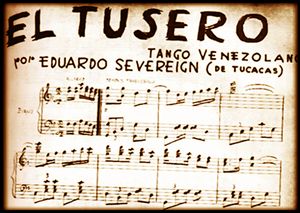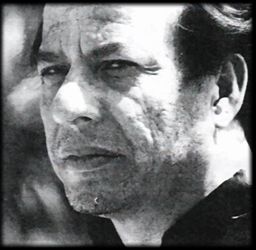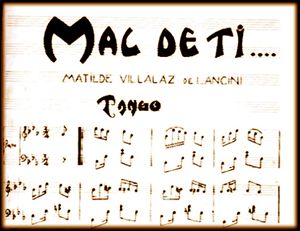By
Tango in Venezuela. An evening with the tangos 'cañoneros'.

he history of tango in Venezuela dates back to the first decade of the twentieth century, when the martial bands and the municipal bands used to play concerts in the open air for all the Caracas denizens that were interested in the invitation that appeared at a small cultural column in El Universal newspaper of then.
 People attending the event were able to enjoy the fashionable variety songs, country waltzes, habaneras and some tangos with names of exotic animals. On some occasions, the newspaper column invited the habitual audience to see the presentation of charming ballerinas that sang and danced to the beat of a country dance, zarzuela or tango.
People attending the event were able to enjoy the fashionable variety songs, country waltzes, habaneras and some tangos with names of exotic animals. On some occasions, the newspaper column invited the habitual audience to see the presentation of charming ballerinas that sang and danced to the beat of a country dance, zarzuela or tango.
In this way Venezuela took an important step towards the re-interpretation of tango, in spite of the fact that the society at that time rejected the vulgarity of its refrains and some later lyrics which were regarded as perverting causes for girls' morals and good behavior.
During the month of August 2000 we made some research about the possible Afro-Cuban origins of Tango. At the Hemeroteca Nacional (National magazine library) we were surprised to find a sheet music for piano with a tango criollo of the year 1941 called “El Tusero” and composed by Eduardo Severing, a character born in Tucacas, a town of the central coast of Venezuela.
The sheet music was very useful for us. For a time we had been thinking of the possibility to gather information for a publication about the History of Tango in Venezuela and precisely that week we had an encounter with the musician, composer, orchestra conductor and author of the acclaimed symphonic work “Tango Cortázar” (1984): Juan Carlos Núñez.
 Juan Carlos Núnez is, according to our point of view, an eccentric and original man. Born in Caracas after the war (1947) he had conceived his life as a time to create with the same freedom as a bird rehearses his early songs every morning. In 1973 he traveled to Warsaw to study orchestral conduction at the PWSM state school. Later he conducted the orchestra of the Warsaw Conservatory and the one of La Fenice Theater in Venice. The year before he was awarded the National Prize of Music with the work “Tocata sinfónica” (1972).
Juan Carlos Núnez is, according to our point of view, an eccentric and original man. Born in Caracas after the war (1947) he had conceived his life as a time to create with the same freedom as a bird rehearses his early songs every morning. In 1973 he traveled to Warsaw to study orchestral conduction at the PWSM state school. Later he conducted the orchestra of the Warsaw Conservatory and the one of La Fenice Theater in Venice. The year before he was awarded the National Prize of Music with the work “Tocata sinfónica” (1972).
Nowadays and being its founder, he heads the school of composition Cátedra Latinoamericana de Composición Antonio Estevez. But the strangest thing in his career was the fact that he left his academic studies for he thought they limited his capacity for creation. He could not even imagine himself repeating the classical, the baroque pieces for a lifetime... he had need of hearing his inner melodies to transcribe them later to the music staff. Today his irreverence has resulted fruitful and he is regarded by critics as one of the musicians most acclaimed of our nation.
The evening of the interview took place in the east of Caracas. We talked about many things, among them we mentioned the name of Nezahuacoyotl, the highest poet of Mexican pre-Spanish influence, a subject that he passionately loves and which is a reason of his research for the release of a new musical work. Even though he did not give me many details about, he told me that Astor Piazzolla, whom he considered his friend, unveiled to him some orchestral secrets in the 70s.
 We, those whose were there that evening, had to ask him to play some pieces on the piano and I even dared to recite the lines of “Mano a mano” with his accompaniment and I further requested him to play a couple of tangos that I had found at the Hemeroteca Nacional: they were the tangos “El Tusero” by Severing and “Mal de ti” by Matilde Villalaz de Lancini, the latter included lyrics and had been composed in January 1937.
We, those whose were there that evening, had to ask him to play some pieces on the piano and I even dared to recite the lines of “Mano a mano” with his accompaniment and I further requested him to play a couple of tangos that I had found at the Hemeroteca Nacional: they were the tangos “El Tusero” by Severing and “Mal de ti” by Matilde Villalaz de Lancini, the latter included lyrics and had been composed in January 1937.
With a tape recorder in hand and with all my senses ready for melody, I enjoyed of an evening that made me reminisce the old music played by the bands of cañoneros who kept the rhythmic and melodic airs of our country since the government of the great Venezuelan, General Guzmán Blanco (1870). Many of these musicians died between the 20s and the 30s, and by the time I was a young kid the bands which played at the provincial public squares began to dismember. Old times that shall never return.
Juan Carlos Núñez's commentaries coincided with our points of view; they were not tangos, pieces made to fit to the recognizable beat of the genre, they were, as a matter of fact, milonga-like habaneras with a typical Venezuelan flavor. The music of the tango “Mal de ti” turned out romantic and sadly reminiscing, much smoother and sweeter in cadence than “El Tusero”, even though its lyrics is after the same formula of the tangos of the period.
So the evening ended, by enjoying two Venezuelan tangos which had not been played for half a century, their chords revived the times of a romantic joyful society and so we understood the hearts of people of days gone by.